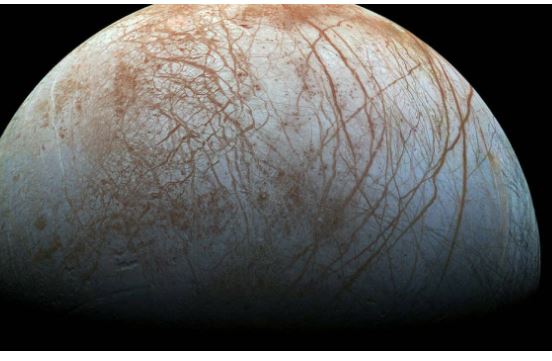
NASA’s James Webb detects carbon dioxide on Jupiter’s moon Europa, signalling potential for life
text_fieldsAstronomers using data from NASA's James Webb Space Telescope have uncovered vital evidence of carbon dioxide on the icy surface of Jupiter's moon Europa. This revelation suggests that the carbon likely originated in Europa's subsurface ocean, raising tantalizing prospects for the potential habitability of this enigmatic moon.
The findings, detailed in two independent papers, have sent shockwaves through the scientific community and ignited hopes of finding extra-terrestrial life.
Europa, one of the most promising celestial bodies in our solar system to harbour life, has long fascinated planetary scientists. Its icy exterior conceals a vast subsurface ocean of liquid water beneath, making it a prime candidate for habitability.
However, one critical question had remained unanswered: does Europa's ocean contain the essential chemicals for life, particularly carbon?
The answer has finally arrived, and it's a resounding yes. "On Earth, life thrives on chemical diversity, and carbon is a cornerstone of our biology. Understanding the chemistry of Europa's ocean will help us determine whether it's a suitable place for life," stated Geronimo Villanueva of NASA's Goddard Space Flight Center, the lead author of one of the research papers.
The carbon dioxide detected on Europa's surface is most concentrated in an area known as Tara Regio, characterized by its geologically youthful terrain, referred to as "chaos terrain." This region has experienced surface disruptions, suggesting a potential exchange of material between the subsurface ocean and the surface ice.
Samantha Trumbo of Cornell University, lead author of the second paper, noted, "Previous observations from the Hubble Space Telescope had already hinted at the presence of ocean-derived salt in Tara Regio. Now, we have confirmation that carbon dioxide is also heavily concentrated here, indicating that the carbon most likely originates in the internal ocean."
The discovery of carbon dioxide on Europa's surface is especially significant because this compound is not stable in the moon's harsh surface conditions. This implies that it must have been supplied relatively recently on a geological timescale, further supporting the idea that it originates from Europa's subsurface ocean.
While the Webb telescope's observations only required a few minutes of its time, they have yielded profound insights. "Even with this short period of time, we were able to do really big science," noted Heidi Hammel of the Association of Universities for Research in Astronomy, emphasizing the immense potential of the James Webb Space Telescope.
One burning question regarding Europa has been the existence of plumes—eruptions of water vapour from its surface. Previous observations using the Hubble Space Telescope suggested the presence of plumes in 2013, 2016, and 2017, though definitive proof remained elusive.
The new data from the Webb telescope, however, indicates no evidence of plume activity during its observations. Villanueva's team has set a strict upper limit on the potential rate of material being ejected from Europa's surface. Still, it's important to note that this non-detection does not definitively rule out the existence of plumes. "There is always a possibility that these plumes are variable and that you can only see them at certain times," explained Hammel, underscoring the complexity of Europa's geology.
This monumental discovery is expected to significantly inform upcoming missions to Europa. NASA's Europa Clipper spacecraft, set to launch in October 2024, will conduct dozens of close flybys to investigate the moon's potential habitability further. Additionally, ESA's Jupiter Icy Moons Explorer (JUICE) will benefit from these findings, enhancing our understanding of Jupiter's icy moons.

















